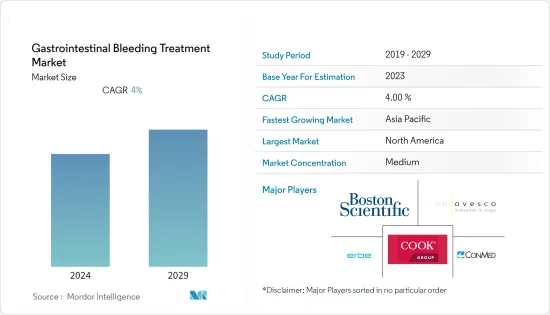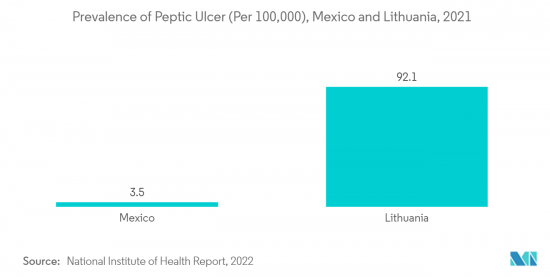 |
市場調査レポート
商品コード
1405679
消化管出血治療:市場シェア分析、産業動向と統計、2024年~2029年の成長予測Gastrointestinal Bleeding Treatment - Market Share Analysis, Industry Trends & Statistics, Growth Forecasts 2024 - 2029 |
||||||
● お客様のご希望に応じて、既存データの加工や未掲載情報(例:国別セグメント)の追加などの対応が可能です。 詳細はお問い合わせください。
| 消化管出血治療:市場シェア分析、産業動向と統計、2024年~2029年の成長予測 |
|
出版日: 2024年01月04日
発行: Mordor Intelligence
ページ情報: 英文 110 Pages
納期: 2~3営業日
|
- 全表示
- 概要
- 目次
消化管出血治療市場は予測期間中に4%のCAGRで推移する見込み。

COVID-19パンデミックは市場に悪影響を及ぼしました。2021年2月にNational Library of Medicineに掲載された論文によると、軟性内視鏡検査はがんのスクリーニング、監視、治療プログラムにおいて大きな役割を果たしています。COVID-19がヘルスケア従事者に感染する危険性があるため、ほとんどの医療施設ではロックダウン期間中、緊急性のない処置や診断処置を中止しました。COVID-19発生時の処置の停止は市場の成長に影響を与えました。しかし、世界の診断・治療手順の再開により、市場は今後数年間で牽引力を増すと予想されます。さらに、製品上市などのイニシアチブは市場成長を高めると予想されます。例えば、2021年10月にFUJIFILM Healthcare Americas Corporationはデュアルチャンネル軟性内視鏡El-740D/Sを発売しました。これは、米国食品医薬品局(FDA)から上部消化管と下部消化管の両方で使用するための承認を受けた最初のデュアルチャネル内視鏡の1つです。このような規制当局からの承認は、技術的に先進的で幅広い用途に使用できる胃内視鏡にも適用され、市場セグメントの成長を促進しています。
消化管出血とは、消化器官内で起こる出血を指します。上部消化管出血の有病率の高さ、内視鏡的止血術の用途の増加、高齢者人口の増加が、消化管出血治療市場の成長を後押ししている主な要因です。胃がん、腫瘍、その他の慢性疾患の負担増、技術の進歩、製品の発売などの要因が、市場セグメントの成長を促進しています。米国疾病予防管理センターによると、2021年に米国で潰瘍と診断された成人の数は1,480万人で、診断された成人の割合はわずか5.9%に過ぎないです。新興諸国を含む多くの政府が、これらの疾患の診断を増やすためのイニシアチブをとっています。
主要な市場参入企業による取り組みも、市場成長の要因のひとつです。例えば、2021年10月、FUJIFILM Healthcare Americas Corporationは、10月22日から27日にラスベガスで開催されたAmerican College of Gastroenterology(ACG)の年次大会のブース1323において、消化器内科医向けのソリューションのフルラインを展示しました。同様に、富士フイルムヘルスケアは2021年3月に富士フイルムの100%子会社として事業を開始し、日立製作所の画像診断関連事業の買収を完了しました。このように、疾病の蔓延の増加と主要市場プレイヤーの取り組みが相まって、市場の成長を後押しすることが予想されます。
しかし、熟練労働者の不足が予測期間中の市場成長を抑制すると予想されます。
消化管出血治療市場の動向
上部消化管部門は予測期間中に良好な成長が見込まれる
GI管別に見ると、市場は上部GI管と下部GI管に区分されます。上部消化管は消化管出血治療市場において大きな成長を占めており、この傾向は予測期間中も続くとみられます。消化性潰瘍は上部消化管出血の最も一般的な原因の一つであり、ピロリ菌感染の増加により有病率が増加していることが知られています。地域に関係なく、消化性潰瘍の症例は世界中で不健康な食習慣のためにかなり一般的です。さらに、消化性潰瘍(PUD)のような他の胃疾患も世界的に増加しており、これが胃腸機器の需要を増大させています。例えば、2022年6月に発表された国立衛生研究所の報告書によると、メキシコとリトアニアでは、2021年のPUD入院発生率は人口10万人当たり3.5~92.1人になると予測されています。さらに、2021年にはOECD加盟36カ国全体で329,000人がPUDで入院すると予測されました。このように、消化器疾患の有病率の増加は、市場の成長を増大させると予想されます。
さまざまな規制当局による新製品の承認が、市場セグメントの成長を促進しています。例えば、2022年2月、Ambuは米国でAmbu aScope GastroとAmbu aBox 2について米国食品医薬品局から510(k)規制認可を取得しました。aScope GastroはAmbu初の無菌単回使用胃カメラで、次世代ディスプレイとプロセッサー技術を組み合わせたソリューションに新しい高度な画像処理機能と設計機能を搭載しています。HD機能を搭載したaBox 2は、画質の面で新たな基準を打ち立て、アンビューの内視鏡エコシステムの中心となります。このような承認が市場セグメントの成長を後押ししています。このように、製品承認と相まって疾病の蔓延が増加していることから、予測期間中にセグメントの成長が拡大すると予想されます。

北米が消化管出血治療市場で大きなシェアを占める見通し
北米は、先進的な治療オプションに対する需要の高まりと上部消化管出血の流行により、市場をリードしています。2021年1月に更新された米国がん協会の記事によると、2021年に米国で新たに診断された結腸がんの症例数は104,270例、直腸がんの症例数は45,230例と推定されています。同出典はまた、全体として、大腸がんの生涯発症リスクは男性で約23人に1人(4.3%)、女性で約25人に1人(4.0%)であると報告しています。そのため、特に進行期に、より良い治療を求めて病院を訪れる患者の負担が増加しています。これが消化管出血治療市場を牽引しています。
臨床試験も市場成長の要因の一つです。例えば、2022年3月、メドトロニックPLCは、大腸内視鏡検査中に大腸ポリープを検出する補助としてAIを使用し、大腸がん(CRC)の予防に役立つ可能性のあるGI Geniusインテリジェント内視鏡モジュールの有効性を確認した無作為化国際多施設研究の最終結果を発表しました。この研究では、GI Geniusを大腸内視鏡検査と併用することで、標準的な大腸内視鏡検査と比較して、大腸ポリープや腺腫の見逃し率(2倍)が有意に低下することが示されました。したがって、このような臨床試験により、このような機器の採用が増加し、市場の成長が期待されます。
このように、この地域におけるこのような疾患の流行は、調査研究と相まって、予測期間中の市場成長を増加させると予想されます。
消化管出血治療産業の概要
消化管出血治療市場は適度に断片化されています。消化管出血治療市場の主要企業には、Boston Scientific Corporation、CONMED Corporation、Cook Group、ERBE Elektromedizin GmbH、Olympus Corporation、Ovesco Endoscopy AG、STERIS PLC、米国Medical Innovationsなどがあります。
その他の特典:
- エクセル形式の市場予測(ME)シート
- 3ヶ月間のアナリストサポート
目次
第1章 イントロダクション
- 調査の前提条件と市場定義
- 調査範囲
第2章 調査手法
第3章 エグゼクティブサマリー
第4章 市場力学
- 市場概要
- 市場促進要因
- 上部消化管出血の負担増
- 消化器疾患治療に関する技術の進歩
- 市場抑制要因
- 熟練労働者の不足
- ポーターのファイブフォース分析
- 新規参入業者の脅威
- 買い手/消費者の交渉力
- 供給企業の交渉力
- 代替品の脅威
- 競争企業間の敵対関係の強さ
第5章 市場セグメンテーション(市場規模)
- 製品別
- 内視鏡用メカニカルデバイス
- 内視鏡用サーマルデバイス
- その他の製品
- 消化管部門別
- 上部消化管
- 下部消化管
- エンドユーザー別
- 病院/クリニック
- 外来手術センター
- その他のエンドユーザー
- 地域別
- 北米
- 米国
- カナダ
- メキシコ
- 欧州
- ドイツ
- 英国
- フランス
- イタリア
- スペイン
- その他の欧州
- アジア太平洋
- 中国
- 日本
- インド
- オーストラリア
- 韓国
- その他のアジア太平洋地域
- 中東・アフリカ
- GCC
- 南アフリカ
- その他の中東とアフリカ
- 南米
- ブラジル
- アルゼンチン
- その他の南米
- 北米
第6章 競合情勢
- 企業プロファイル
- Boston Scientific Corporation
- CONMED Corporation
- Cook Group
- ERBE Elektromedizin GmbH
- Medtronic PLC
- Olympus Corporation
- Ovesco Endoscopy AG
- Pfizer Inc.
- STERIS PLC
- US Medical Innovations
第7章 市場機会と今後の動向

The Gastrointestinal Bleeding Treatment Market is poised to witness a CAGR of 4% during the forecast period.
The COVID-19 pandemic had an adverse effect on the market. An article published in the National Library of Medicine in February 2021 reported that flexible endoscopy plays a major role in cancer screening, surveillance, and treatment programs. Due to the risk of COVID-19 transmission to healthcare workers, most healthcare facilities halted non-emergency and diagnostic procedures during the lockdown. The halting of procedures during the time of COVID-19 impacted the growth of the market. However, the market is anticipated to gain traction over the coming years owing to the resumption of diagnosis and treatment procedures globally. Furthermore, initiatives such as product launches are expected to increase market growth. For instance, in October 2021, FUJIFILM Healthcare Americas Corporation launched the El-740D/S dual-channel flexible endoscope. It is one of the first dual-channel endoscopes that has received approval from the United States Food and Drug Administration (FDA) for use in both upper and lower gastrointestinal applications. Such approvals from the regulatory authority to technically advanced and wide-application gastroscopes are also fostering the growth of the market segment.
Gastrointestinal bleeding refers to blood loss that occurs within the digestive organs. The high prevalence of upper gastrointestinal bleeding, the rise in applications of endoscopic hemostasis, and the growing geriatric population are the main factors that are boosting the growth of the gastrointestinal bleeding treatment market. Factors such as the growing burden of gastric cancers, tumors, and other chronic diseases, advancement in technology, and the launch of products are driving the growth of the market segment. According to the Centers for Disease Control and Prevention, in 2021, the number of adults diagnosed with ulcers in the United States was 14.8 million, with the percentage of adults diagnosed being merely 5.9%. Many governments, including the ones of developing countries, are taking initiatives to increase the diagnosis of these diseases.
Initiatives by key market players are another factor in market growth. For instance, in October 2021, FUJIFILM Healthcare Americas Corporation exhibited its full line of solutions for gastroenterologists at the annual convention of the American College of Gastroenterology (ACG) booth 1323 in Las Vegas on October 22-27. Similarly, in March 2021, Fujifilm Healthcare started operating as a fully owned subsidiary of FUJIFILM and completed the acquisition of the diagnostic imaging-related business of Hitachi Ltd. Thus, the increasing prevalence of diseases, coupled with initiatives by key market players, is expected to help the market growth.
However, the dearth of skilled labor is expected to restrain the growth of the market in the forecast period.
Gastrointestinal Bleeding Treatment Market Trends
Upper GI Tract Segment is Expected to Register a Good Growth Over the Forecast Period
By GI tract division, the market has been segmented into Upper GI Tract and Lower GI Tract. The upper GI tract accounted for a significant growth in the gastrointestinal bleeding treatment market, and this trend is likely to continue during the forecast period. A peptic ulcer is one of the most common causes of upper GI tract bleeding and is known to have increased prevalence owing to an increase in H. pylori infection. Irrespective of any region, peptic ulcer cases are quite common because of unhealthy diet habits across the world. Furthermore, other gastric diseases, such as Peptic Ulcer (PUD), are increasing worldwide, which is augmenting the demand for gastrointestinal devices. For instance, the National Institute of Health report published in June 2022 stated that in Mexico and Lithuania, the incidence of PUD hospitalizations was predicted to be between 3.5 and 92.1 per 100,000 people in 2021. Additionally, in 2021, it was anticipated that 329,000 people would be hospitalized for PUD across the OECD's 36 member countries. Thus, the increasing prevalence of GI disorders is expected to increase the market growth.
The approval of new products by different regulatory authorities is driving the growth of the market segment. For instance, in February 2022, Ambu received 510(k) regulatory clearance from the United States Food and Drug Administration for Ambu aScope Gastro and Ambu aBox 2 in the United States. aScope Gastro is Ambu's one of the first sterile single-use gastroscopes and includes new advanced imaging and design features in a combined solution with next-generation display and processor technology. With HD capabilities, the aBox 2 will set a new benchmark in terms of image quality and will be at the center of Ambu's endoscopy ecosystem. Such approvals are propelling the growth of the market segment. Thus, the increasing prevalence of diseases coupled with product approval is expected to increase segmental growth over the forecast period.

North America is Expected to Have Significant Share in the Gastrointestinal Bleeding Treatment Market
North America leads the market owing to the upsurge in the demand for advanced treatment options and the prevalence of upper gastrointestinal bleeding. The American Cancer Society article updated in January 2021 reported that in 2021, there were an estimated 104,270 new cases of colon cancer and 45,230 new cases of rectal cancer diagnosed in the United States. The same source also reported that overall, the lifetime risk of developing colorectal cancer is about 1 in 23 (4.3%) for men and 1 in 25 (4.0%) for women. Thus, a growing burden of such patients is being observed approaching the hospitals for better treatment, particularly during the advanced stage of the disease. This drives the market for gastrointestinal bleeding treatment.
Clinical trials are another factor in market growth. For instance, in March 2022, Medtronic PLC released the final findings from a randomized, international, multicenter study that confirmed the effectiveness of the GI Genius intelligent endoscopy module, which uses AI as an aid in detecting colorectal polyps during colonoscopy, potentially helping to prevent colorectal cancer (CRC). The study showed that the use of GI Genius in conjunction with colonoscopy significantly decreases the miss rate (2x) of colorectal polyps and adenomas compared to standard colonoscopy. Thus, such clinical trials are expected to increase the adoption of such devices, which is expected to increase the market growth.
Thus, the prevalence of such diseases in the region, coupled with the research studies, is expected to increase market growth over the forecast period.
Gastrointestinal Bleeding Treatment Industry Overview
The Gastrointestinal Bleeding Treatment Market is moderately fragmented. The major players in the gastrointestinal bleeding treatment market include Boston Scientific Corporation, CONMED Corporation, Cook Group, ERBE Elektromedizin GmbH, Olympus Corporation, Ovesco Endoscopy AG, STERIS PLC, and US Medical Innovations.
Additional Benefits:
- The market estimate (ME) sheet in Excel format
- 3 months of analyst support
TABLE OF CONTENTS
1 INTRODUCTION
- 1.1 Study Assumptions and Market Definition
- 1.2 Scope of the Study
2 RESEARCH METHODOLOGY
3 EXECUTIVE SUMMARY
4 MARKET DYNAMICS
- 4.1 Market Overview
- 4.2 Market Drivers
- 4.2.1 Growing Burden of Upper Gastrointestinal Bleeding
- 4.2.2 Technology Advancements Related to Gastrointestinal Diseases Treatment
- 4.3 Market Restraints
- 4.3.1 Dearth of Skilled Labor
- 4.4 Porter's Five Forces Analysis
- 4.4.1 Threat of New Entrants
- 4.4.2 Bargaining Power of Buyers/Consumers
- 4.4.3 Bargaining Power of Suppliers
- 4.4.4 Threat of Substitute Products
- 4.4.5 Intensity of Competitive Rivalry
5 MARKET SEGMENTATION (Market Size by Value - USD million)
- 5.1 By Product
- 5.1.1 Endoscopic Mechanical Devices
- 5.1.2 Endoscopic Thermal Devices
- 5.1.3 Other Products
- 5.2 By GI Tract Division
- 5.2.1 Upper GI Tract
- 5.2.2 Lower GI Tract
- 5.3 By End User
- 5.3.1 Hospitals/Clinics
- 5.3.2 Ambulatory Surgical Centres
- 5.3.3 Other End Users
- 5.4 Geography
- 5.4.1 North America
- 5.4.1.1 United States
- 5.4.1.2 Canada
- 5.4.1.3 Mexico
- 5.4.2 Europe
- 5.4.2.1 Germany
- 5.4.2.2 United Kingdom
- 5.4.2.3 France
- 5.4.2.4 Italy
- 5.4.2.5 Spain
- 5.4.2.6 Rest of Europe
- 5.4.3 Asia-Pacific
- 5.4.3.1 China
- 5.4.3.2 Japan
- 5.4.3.3 India
- 5.4.3.4 Australia
- 5.4.3.5 South Korea
- 5.4.3.6 Rest of Asia-Pacific
- 5.4.4 Middle-East and Africa
- 5.4.4.1 GCC
- 5.4.4.2 South Africa
- 5.4.4.3 Rest of Middle-East and Africa
- 5.4.5 South America
- 5.4.5.1 Brazil
- 5.4.5.2 Argentina
- 5.4.5.3 Rest of South America
- 5.4.1 North America
6 COMPETITIVE LANDSCAPE
- 6.1 Company Profiles
- 6.1.1 Boston Scientific Corporation
- 6.1.2 CONMED Corporation
- 6.1.3 Cook Group
- 6.1.4 ERBE Elektromedizin GmbH
- 6.1.5 Medtronic PLC
- 6.1.6 Olympus Corporation
- 6.1.7 Ovesco Endoscopy AG
- 6.1.8 Pfizer Inc.
- 6.1.9 STERIS PLC
- 6.1.10 US Medical Innovations
